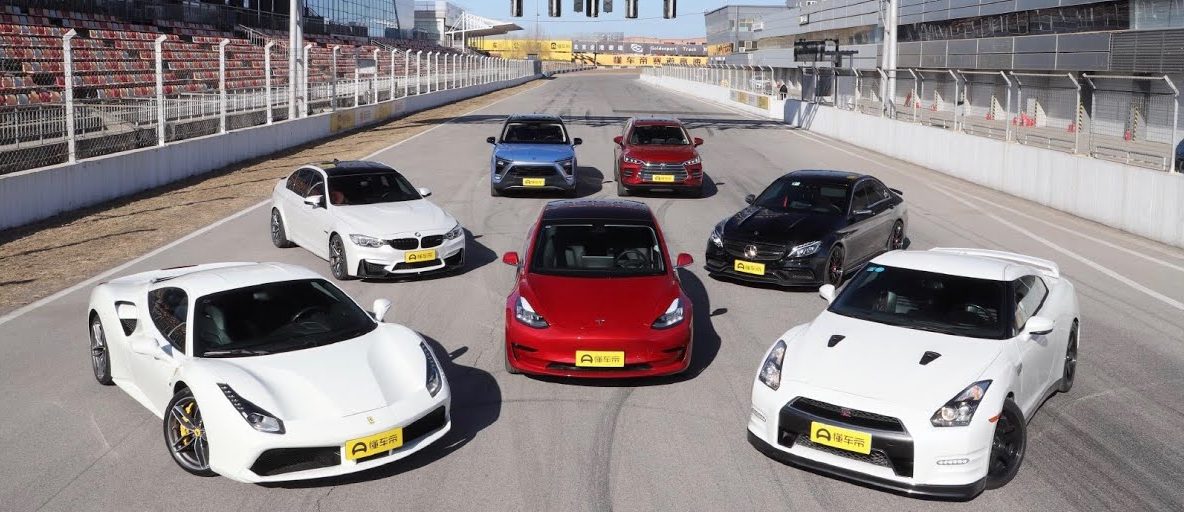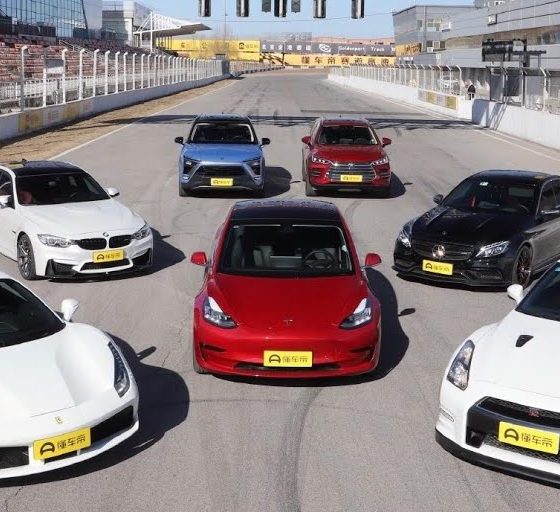

News
Tesla Model 3 Performance takes on supercars, high-performance sedans in track battle
When Elon Musk first announced the specs of the Tesla Model 3 Performance, he noted that the electric car would beat anything on its class inside a closed circuit. With its dual motors that produced a combined 450 hp and 471 lb-ft of torque, its 0-60 mph time of 3.5 seconds, and its top speed of 155 mph, Musk noted that the top variant of the Model 3 would cost roughly the same as a BMW M3, but be “15% quicker and with better handling.”
It should be noted that Musk mentioned the Model 3 Performance’s comparison with the BMW M3 at a time when Tesla was yet to reveal that it was developing a dedicated Track Mode for the electric sedan. With Track Mode, which optimizes the car for intensive closed circuit driving, the Model 3 Performance becomes a very formidable car on the racetrack. Over the past months, videos of the Model 3 Performance that have been shared online have mostly featured the vehicle competing in drag races or going around race tracks on its own. Rarely has there been a test of the car competing on a closed circuit against other high-performance vehicles.
That is, until recently, when Chinese auto group Know the Car (credit to Tesla community member JayinShanghai for sharing the video) opted to test the Model 3 Performance against several notable competitors. The group selected three groups of vehicles that would compete against the electric car — Chinese-made EVs, the NIO ES8 and the BYD唐DM; high-performance sedans, the BMW M3 and the Mercedes-AMG C63; and supercars, the Nissan GT-R and the Ferrari 488 GTB.
The tests were conducted at the Goldenport Park Circuit in Beijing, China in -5°C (23°F) weather. In its first test, the group opted to test the Model 3 Performance’s acceleration. Thanks to the instant torque from its dual electric motors, the electric sedan soundly dominated its competitors. After beating the competition on the straight line test, the group opted to call a professional driver to see just how well the Model 3 Performance stacked up against the six other vehicles on the track.
It should be noted that Beijing’s Goldenport Park Circuit is a location that is known to favor cornering and technical driving over high-speed, straight-line acceleration. Thus, during the tests, the Model 3 Performance, with its Track Mode enabled, was driven hard from one corner to the other. When the track times of the six vehicles were compared, it became evident that Elon Musk’s words about the electric car were accurate.
At the bottom of the rankings were the two Chinese-made EVs, which is understandable considering that the NIO ES8 and the BYD唐DM were SUVs. Immediately following the two EVs was the BMW M3, which was able to complete a lap around the track in 01:22.67. The Mercedes-AMG C 63 fared better than the M3, finishing a lap in 01:20.23. True to Elon Musk’s words, the Tesla Model 3 Performance dominated its class, with its lap time of 01:18.62.
Only two vehicles proved faster than the Model 3 Performance around the track — the Ferrari 488 GTB, which finished a lap in 01:16.31, and the Nissan GT-R, which completed a lap in 01:15.23. As noted by the group that conducted the test, the Model 3 Performance was ultimately outgunned only by vehicles that are beyond its class and its price range (credit to David Jao for the translation).
“The data doesn’t lie. China’s new electric entrants compared to the Model 3 are still far behind. The cars that we previously worshipped as high-end sedans, regretfully defeated. Only the supercars, costing 3-5 times the Model 3 remain to defend the honor of the internal combustion engine (ICE). So the appearance of the Model 3 brings forth a new kind of performance — cheaper, quieter, and even faster.”
The group’s statement about the prices of the Model 3’s rivals in the Chinese market is no exaggeration. Tesla lists the Model 3 Performance with a price of 560,000 RMB (around $81,000) for the Chinese market. While higher than its $64,000 price in the United States, the Model 3 Performance is still considerably more affordable than its rival high-performance sedans in the country. The BMW M3, for one, sells for 998,000 RMB ($162,000), while the Mercedes-AMG C 63 Coupe costs 1,198,000 RMB ($173,623). With its price in the Chinese market, Tesla all but made the Model 3 Performance as the ultimate bang-for-your-buck high-performance sedan — quicker, cleaner, and cheaper than the competition.
Watch the Tesla Model 3 Performance battle local high-performance sedans and supercars on the track in the video below.

Elon Musk
Elon Musk and Tesla AI Director share insights after empty driver seat Robotaxi rides
The executives’ unoccupied tests hint at the rapid progress of Tesla’s unsupervised Robotaxi efforts.

Tesla CEO Elon Musk and AI Director Ashok Elluswamy celebrated Christmas Eve by sharing personal experiences with Robotaxi vehicles that had no safety monitor or occupant in the driver’s seat. Musk described the system’s “perfect driving” around Austin, while Elluswamy posted video from the back seat, calling it “an amazing experience.”
The executives’ unoccupied tests hint at the rapid progress of Tesla’s unsupervised Robotaxi efforts.
Elon and Ashok’s firsthand Robotaxi insights
Prior to Musk and the Tesla AI Director’s posts, sightings of unmanned Teslas navigating public roads were widely shared on social media. One such vehicle was spotted in Austin, Texas, which Elon Musk acknowleged by stating that “Testing is underway with no occupants in the car.”
Based on his Christmas Eve post, Musk seemed to have tested an unmanned Tesla himself. “A Tesla with no safety monitor in the car and me sitting in the passenger seat took me all around Austin on Sunday with perfect driving,” Musk wrote in his post.
Elluswamy responded with a 2-minute video showing himself in the rear of an unmanned Tesla. The video featured the vehicle’s empty front seats, as well as its smooth handling through real-world traffic. He captioned his video with the words, “It’s an amazing experience!”
Towards Unsupervised operations
During an xAI Hackathon earlier this month, Elon Musk mentioned that Tesla owed be removing Safety Monitors from its Robotaxis in Austin in just three weeks. “Unsupervised is pretty much solved at this point. So there will be Tesla Robotaxis operating in Austin with no one in them. Not even anyone in the passenger seat in about three weeks,” he said. Musk echoed similar estimates at the 2025 Annual Shareholder Meeting and the Q3 2025 earnings call.
Considering the insights that were posted Musk and Elluswamy, it does appear that Tesla is working hard towards operating its Robotaxis with no safety monitors. This is quite impressive considering that the service was launched just earlier this year.
Elon Musk
Starlink passes 9 million active customers just weeks after hitting 8 million
The milestone highlights the accelerating growth of Starlink, which has now been adding over 20,000 new users per day.

SpaceX’s Starlink satellite internet service has continued its rapid global expansion, surpassing 9 million active customers just weeks after crossing the 8 million mark.
The milestone highlights the accelerating growth of Starlink, which has now been adding over 20,000 new users per day.
9 million customers
In a post on X, SpaceX stated that Starlink now serves over 9 million active users across 155 countries, territories, and markets. The company reached 8 million customers in early November, meaning it added roughly 1 million subscribers in under seven weeks, or about 21,275 new users on average per day.
“Starlink is connecting more than 9M active customers with high-speed internet across 155 countries, territories, and many other markets,” Starlink wrote in a post on its official X account. SpaceX President Gwynne Shotwell also celebrated the milestone on X. “A huge thank you to all of our customers and congrats to the Starlink team for such an incredible product,” she wrote.
That growth rate reflects both rising demand for broadband in underserved regions and Starlink’s expanding satellite constellation, which now includes more than 9,000 low-Earth-orbit satellites designed to deliver high-speed, low-latency internet worldwide.
Starlink’s momentum
Starlink’s momentum has been building up. SpaceX reported 4.6 million Starlink customers in December 2024, followed by 7 million by August 2025, and 8 million customers in November. Independent data also suggests Starlink usage is rising sharply, with Cloudflare reporting that global web traffic from Starlink users more than doubled in 2025, as noted in an Insider report.
Starlink’s momentum is increasingly tied to SpaceX’s broader financial outlook. Elon Musk has said the satellite network is “by far” the company’s largest revenue driver, and reports suggest SpaceX may be positioning itself for an initial public offering as soon as next year, with valuations estimated as high as $1.5 trillion. Musk has also suggested in the past that Starlink could have its own IPO in the future.
News
NVIDIA Director of Robotics: Tesla FSD v14 is the first AI to pass the “Physical Turing Test”
After testing FSD v14, Fan stated that his experience with FSD felt magical at first, but it soon started to feel like a routine.

NVIDIA Director of Robotics Jim Fan has praised Tesla’s Full Self-Driving (Supervised) v14 as the first AI to pass what he described as a “Physical Turing Test.”
After testing FSD v14, Fan stated that his experience with FSD felt magical at first, but it soon started to feel like a routine. And just like smartphones today, removing it now would “actively hurt.”
Jim Fan’s hands-on FSD v14 impressions
Fan, a leading researcher in embodied AI who is currently solving Physical AI at NVIDIA and spearheading the company’s Project GR00T initiative, noted that he actually was late to the Tesla game. He was, however, one of the first to try out FSD v14.
“I was very late to own a Tesla but among the earliest to try out FSD v14. It’s perhaps the first time I experience an AI that passes the Physical Turing Test: after a long day at work, you press a button, lay back, and couldn’t tell if a neural net or a human drove you home,” Fan wrote in a post on X.
Fan added: “Despite knowing exactly how robot learning works, I still find it magical watching the steering wheel turn by itself. First it feels surreal, next it becomes routine. Then, like the smartphone, taking it away actively hurts. This is how humanity gets rewired and glued to god-like technologies.”
The Physical Turing Test
The original Turing Test was conceived by Alan Turing in 1950, and it was aimed at determining if a machine could exhibit behavior that is equivalent to or indistinguishable from a human. By focusing on text-based conversations, the original Turing Test set a high bar for natural language processing and machine learning.
This test has been passed by today’s large language models. However, the capability to converse in a humanlike manner is a completely different challenge from performing real-world problem-solving or physical interactions. Thus, Fan introduced the Physical Turing Test, which challenges AI systems to demonstrate intelligence through physical actions.
Based on Fan’s comments, Tesla has demonstrated these intelligent physical actions with FSD v14. Elon Musk agreed with the NVIDIA executive, stating in a post on X that with FSD v14, “you can sense the sentience maturing.” Musk also praised Tesla AI, calling it the best “real-world AI” today.








